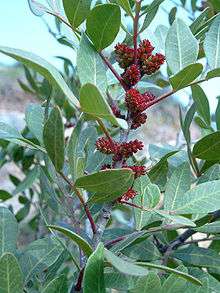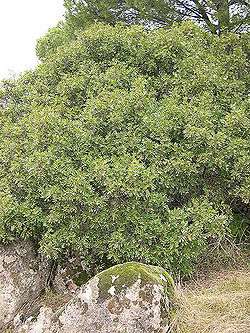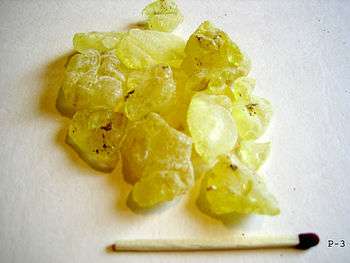Pistacia lentiscus
| Pistacia lentiscus Mastic | |
|---|---|
 | |
| Mastic foliage and flowers | |
| Scientific classification | |
| Kingdom: | Plantae |
| (unranked): | Angiosperms |
| (unranked): | Eudicots |
| (unranked): | Rosids |
| Order: | Sapindales |
| Family: | Anacardiaceae |
| Genus: | Pistacia |
| Species: | P. lentiscus |
| Binomial name | |
| Pistacia lentiscus L. | |
Pistacia lentiscus (also mastic; Greek: μαστίχα mastíkha ) is a dioecious evergreen shrub or small tree of the pistacio genus growing up to 4 m (13 ft) tall which is cultivated for its aromatic resin, mainly on the Greek island of Chios.[1]
Description
Pistacia lentiscus is a shrub or dioecious tree, with separate male and female plants, evergreen from 1 to 5 m high, with a strong smell of resin, growing in dry and rocky areas in Mediterranean Europe. It resists heavy frosts and grows on all types of soils, and can grow well in limestone areas and even in salty or saline environments, making it more abundant near the sea. It is also found in woodlands, dehesas (almost deforested pasture areas), Kermes oak wood, oaks wood, garrigue, maquis, hills, gorges, canyons, and rocky hillsides of the entire Mediterranean area. It is a very typical species that grows in Mediterranean mixed communities of myrtle, Kermes oak, Mediterranean dwarf palm, buckthorn, sarsaparilla, etc. and serves as protection and food for birds and other fauna in this ecosystem. It is a very hardy pioneer species dispersed by birds. When older, it develops some large trunks and numerous thicker and longer branches. In appropriate areas, when allowed to grow freely and age, it often becomes a tree of up to 7 m. However, logging, grazing, and fires often prevent its development.
The leaves are alternate, leathery, and compound paripinnate (no terminal leaflet) with five or six pairs[2] of deep-green leaflets. It presents very small flowers, the male with five stamens, the female trifid style. The fruit is a drupe, first red and then black when ripe, about 4 mm in diameter.
In tourist areas, with palmitos or Mediterranean dwarf palm, and exotic plants, it is often chosen to repopulate gardens and resorts, because of its strength and attractive appearance. Unlike other species of Pistacia, it retains its leaves throughout the year. It has been introduced as an ornamental shrub in Mexico, where it has naturalized and is often seen primarily in suburban and semiarid areas where the summer rainfall climate, contrary to the Mediterranean, does not hurt it.
A related species, P. saportae, has been shown by DNA analysis[3] to be a hybrid between maternal P. lentiscus and paternal P. terebinthus (terebinth or turpentine). The hybrid has imparipinnate leaves, with leaflets semipersistent, subsessile terminal, and sometimes reduced. Usually, P. terebinthus and P. lentiscus occupy different biotopes and barely overlap: Mastic appears at lower elevations and near the sea, while the P. terebinthus most frequently inhabits inland and mountainous areas such as the Iberian System.
Distribution
Pistacia lentiscus is native throughout the Mediterranean region, from Morocco and Iberian peninsula in the west through southern France and Turkey to Iraq and Iran in the east. It is also native to the Canary Islands.[4] The word mastic derives from the Latin word "Masticare" (to chew), in Greek: μαστιχάω verb mastichein ("to gnash the teeth", the English word completely from the Latin masticate) or massein ("to chew").[5]
Within the European Union, mastic production in Chios is granted protected designation of origin and protected geographical indication names.[6] Although the tree is native to all of the Mediterranean region, only on southern Chios is the mastic trees' bark scored to "weep" the masticha resin.[7] The island's mastic production is controlled by a co-operative of medieval villages, collectively known as the 'Mastichochoria' (Μαστιχοχώρια), which are also located in the southern part of Chios.
Resin
The aromatic, ivory-coloured resin, also known as mastic, is harvested as a spice from the cultivated mastic trees grown in the south of the Greek island of Chios in the Aegean Sea, where it is also known by the name "Chios tears". Originally liquid, it is hardened, when the weather turns cold, into drops or patties of hard, brittle, translucent resin. When chewed, the resin softens and becomes a bright white and opaque gum.
Cultivation history
The resin is collected by bleeding the trees from small cuts made in the bark of the main branches, and allowing the sap to drip onto the specially prepared ground below. The harvesting is done during the summer between June and September. After the mastic is collected, it is washed manually and is set aside to dry, away from the sun, as it will start melting again.

Mastic resin is a relatively expensive kind of spice; it has been used principally as a chewing gum for at least 2,400 years.[8] The flavour can be described as a strong, slightly smoky, resiny aroma and can be an acquired taste.
Some scholars[9] identify the bakha בכא mentioned in the Bible—as in the Valley of Baca (Hebrew: עמק הבכא) of Psalm 84—with the mastic plant. The word bakha appears to be derived from the Hebrew word for crying or weeping, and is thought to refer to the "tears" of resin secreted by the mastic plant, along with a sad weeping noise which occurs when the plant is walked on and branches are broken. The Valley of Baca is thought to be a valley near Jerusalem that was covered with low mastic shrubbery, much like some hillsides in northern Israel today. In an additional biblical reference, King David receives divine counsel to place himself opposite the Philistines coming up the Valley of Rephaim, southwest of Jerusalem, such that the "sound of walking on the tops of the bakha shrubs" (קול צעדה בראשי הבכאים) signals the moment to attack (II Samuel V: 22–24).
Mastic is known to have been popular in Roman times when children chewed it, and in Medieval times, it was highly prized for the Sultan's harem both as a breath freshener and for cosmetics. It was the Sultan's privilege to chew mastic, and it was considered to have healing properties. The spice's use was widened when Chios became part of the Ottoman Empire, and it remains popular in North Africa and the Near East.
The Mastichochoria (mastic-producing villages) are located in the southern part of Chios.
Uses
Culinary art
Mastic gum is principally used either as a flavouring or for its gum properties, as in mastic chewing gum.
As a spice, it continues to be used in Greece to flavour spirits and liqueurs (such as Chios's native drink Mastiha), chewing gum, and a number of cakes, pastries, spoon sweets, and desserts. Sometimes it is even used in making cheese.[7] Mastic resin is a key ingredient in dondurma (Turkish ice cream) and Turkish puddings, giving those confections their unusual texture and bright whiteness. In Lebanon and Egypt, the spice is used to flavour many dishes, ranging from soups to meats to desserts, while in Morocco, smoke from the resin is used to flavour water. In Turkey, mastic is used as a flavor of Turkish delight. Recently, a mastic-flavoured fizzy drink has also been launched, called "Mast".
Mastic resin is a key ingredient in Greek festival breads, for example, the sweet bread tsoureki and the traditional New Year's vasilopita. Furthermore, mastic is also essential to myron, the holy oil used for chrismation by the Orthodox Churches.[7]
As well as its culinary uses, mastic continues to be used for its gum and medicinal properties. The resin is used as a primary ingredient in the production of cosmetics such as toothpaste, lotions for the hair and skin, and perfumes.

Medicine
People in the Mediterranean region have used mastic as a medicine for gastrointestinal ailments for several thousand years. The first-century Greek physician and botanist, Dioscorides, wrote about the medicinal properties of mastic in his classic treatise De Materia Medica ("About Medical Substances"). Some centuries later, Markellos Empeirikos and Pavlos Eginitis[5] also noticed the effect of mastic on the digestive system.
Regular consumption of mastic has been proven to absorb cholesterol, thus easing high blood pressure and reducing the risk of heart attacks. Mastic oil also has antibacterial and antifungal properties, and as such is widely used in the preparation of ointments for skin disorders and afflictions. It is also used in the manufacture of plasters.[7]
In recent years, university researchers have provided the scientific evidence for the medicinal properties of mastic. A 1985 study by the University of Thessaloniki and by the Meikai University discovered that mastic can reduce bacterial plaque in the mouth by 41.5%. A 1998 study by the University of Athens found that mastic oil has antibacterial and antifungal properties. Another 1998 University of Nottingham study, claims that mastic can heal peptic ulcers by killing Helicobacter pylori, which causes peptic ulcers, gastritis, and duodenitis. Some in vivo studies have shown that mastic gum has no effect on H. pylori when taken for short periods of time.[10][11] However, a recent and more extensive study showed that mastic gum reduced H. pylori populations after an insoluble and sticky polymer (poly-β-myrcene) constituent of mastic gum was removed and taken for a longer period of time. Further analysis showed the acid fraction was the most active antibacterial extract, and the most active pure compound was isomasticadienolic acid.[12]
A balm was created from the mastic tree resin for use by physicians in Biblical times. American slaves took the reference in Jeremiah 8:22 to the Balm of Gilead to refer to Jesus Christ in the spiritual hymn, There is a Balm in Gilead.
Miscellanea
Apart from its medicinal properties and cosmetic and culinary uses, mastic gum is also used in the production of high-grade varnish.
The mastic tree has been introduced into Mexico as an ornamental plant, where it is very prized and fully naturalized. The trees are grown mainly in suburban areas in semiarid zones, and remain undamaged, although the regime of summer rainfall is contrary to its original Mediterranean climate.
Dufte-Zeichen ('Scents-signs'), the 4th scene from Sonntag aus Licht by Karlheinz Stockhausen, is centred around seven scents, each one associated with one day of the week. Mastix is assigned to Wednesday and comes third.
See also
| Wikimedia Commons has media related to Pistacia lentiscus. |
References
- ↑ Pistacia lentiscus L. at Mansfeld's Database Taxonomy
- ↑ Stephenson, J.; Churchill, J.M. (1831). Medical botany, or, Illustrations and descriptions of the medicinal plants of the London, Edinburgh, and Dublin pharmacopoeias: comprising a popular and scientific account of all those poisonous vegetables that are indigenous to Great Britain. J. Churchill.
- ↑ Tingshuang Yi, Jun Wen,Avi Golan-Goldhirsh, and Dan E. Parfitt. Phylogenetics and reticulate evolution in PISTACIA ( Anacardiaceae). American Journal of Botany 95(2): 241–251. 2008. http://www.amjbot.org/content/95/2/241.full.pdf
- ↑ Pistacia lentiscus distribution at Germplasm Resources Information Network
- 1 2 Mastic at e-xios.gr Chios Portal
- ↑ EU PDO/PGI registration
- 1 2 3 4 "The Magic Tree — Marvelous Masticha", Epikouria Magazine, Fall/Winter 2005
- ↑ BBC - Radio 4 - Woman's Hour -Mastic
- ↑ Da'at Mikra, citing Y. Felix
- ↑ Loughlin MF, Ala'Aldeen DA, Jenks PJ (February 2003). "Monotherapy with mastic does not eradicate Helicobacter pylori infection from mice". J. Antimicrob. Chemother. 51 (2): 367–71. doi:10.1093/jac/dkg057. PMID 12562704.
- ↑ Bebb JR, Bailey-Flitter N, Ala'Aldeen D, Atherton JC (September 2003). "Mastic gum has no effect on Helicobacter pylori load in vivo". J. Antimicrob. Chemother. 52 (3): 522–3. doi:10.1093/jac/dkg366. PMID 12888582.
- ↑ Paraschos S, Magiatis P, Mitakou S, et al. (February 2007). "In vitro and in vivo activities of Chios mastic gum extracts and constituents against Helicobacter pylori". Antimicrob. Agents Chemother. 51 (2): 551–9. doi:10.1128/AAC.00642-06. PMC 1797732
 . PMID 17116667.
. PMID 17116667.
Further reading
- Takahashi K, Fukazawa M, Motohira H, Ochiai K, Nishikawa H, Miyata T (April 2003). "A pilot study on antiplaque effects of mastic chewing gum in the oral cavity". J. Periodontol. 74 (4): 501–5. doi:10.1902/jop.2003.74.4.501. PMID 12747455.